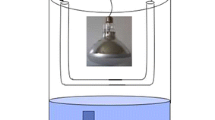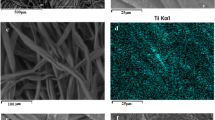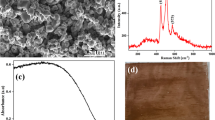Abstract
Functional cotton fabrics with N-halamine structure were prepared by in situ growth of titanium dioxide (TiO2) nanoparticles on PDA/PEI (polydopamine/polyethyleneimine) coating, which effectively solved the problem of bacterial growth and stain adhesion for cotton fabrics. The results of SEM, XRD, and XPS analyses showed that the TiO2 nanoparticles were successfully produced on the surface of the fabric and were spherical at 60 °C. Photoluminescence (PL) spectra showed that PDA and TiO2 were beneficial in improving the electron–hole pairs separation efficiency of the modified fabrics. And the weight percentage of TiO2 nanoparticles deposited on the fabric surface was 14.4% from TG analysis. Photocatalytic experiments showed that the TiO2-deposited cotton fabrics degraded 97.1% of methylene blue (MB) solution within 12 h and had excellent stability. After chlorination, the TiO2-deposited cotton fabrics could sterilize 100% Staphylococcus aureus and Escherichia coli within 30 min, and the TiO2 was able to reduce the chlorine loss of N-halamine upon UV irradiation. By comparing the water contact angles of the TiO2-deposited cotton fabrics at different temperatures, it was found that the TiO2-deposited cotton fabrics at 60 °C have a lotus leaf-like hydrophobic property which brings self-cleaning performance. After loading with TiO2 nanoparticles, the fabrics had desirable cytocompatibility and the breaking strength was also improved.
Graphic abstract














Similar content being viewed by others
Data availability
The supporting Information is available free of charge on the Cellulose Publications website.
References
Ball V (2014) Physicochemical perspective on “polydopamine” and “poly(catecholamine)” films for their applications in biomaterial coatings. Biointerphases 9:030801. https://doi.org/10.1116/1.4875115
Cao L (2017) Novel MoS2 -modified AgVO3 composites with remarkably enhanced photocatalytic activity under visible-light irradiation. Mater Lett 188:252–256. https://doi.org/10.1016/j.matlet.2016.10.120
Chen H, Wang Y-Q, Huang F, Tu C, Cui L (2021) Layer by layer self-assembly MoS2/ZIF-8 composites on carboxyl cotton fabric for enhanced visible light photocatalysis and recyclability. Appl Surf Sci 565:150458. https://doi.org/10.1016/j.apsusc.2021.150458
Cheng D, He M, Ran J, Cai G, Wu J, Wang X (2017) In situ reduction of TiO2 nanoparticles on cotton fabrics through polydopamine templates for photocatalysis and UV protection. Cellulose 25:1413–1424. https://doi.org/10.1007/s10570-017-1606-1
Cheng D, He M, Ran J, Cai G, Wu J, Wang X (2018) Depositing a flexible substrate of triangular silver nanoplates onto cotton fabrics for sensitive SERS detection. Sensor Actuat B Chem 270:508–517. https://doi.org/10.1016/j.snb.2018.05.075
Cheng D, He M, Li W, Wu J, Ran J, Cai G, Wang X (2019) Hydrothermal growing of cluster-like ZnO nanoparticles without crystal seeding on PET films via dopamine anchor. Appl Surf Sci 467–468:534–542. https://doi.org/10.1016/j.apsusc.2018.10.177
Chien H-W, Chiu T-H (2020) Stable N-halamine on polydopamine coating for high antimicrobial efficiency. Eur Polym J 130:109654. https://doi.org/10.1016/j.eurpolymj.2020.109654
Chu S, Miao Y, Qian Y, Ke F, Chen P, Jiang C, Chen X (2019) Synthesis of uniform layer of TiO2 nanoparticles coated on natural cellulose micrometer-sized fibers through a facile one-step solvothermal method. Cellulose 26:4757–4765. https://doi.org/10.1007/s10570-019-02425-w
Del Frari D, Bour J, Ball V, Toniazzo V, Ruch D (2012) Degradation of polydopamine coatings by sodium hypochlorite: a process depending on the substrate and the film synthesis method. Polym Degrad Stabil 97:1844–1849. https://doi.org/10.1016/j.polymdegradstab.2012.05.002
Ding F, Zhang S, Ren X, Huang T-S (2021) Development of PET Fabrics containing N-halamine compounds with durable antibacterial property. Fiber Polym 23:413–422. https://doi.org/10.1007/s12221-021-0448-5
Gao D, Lyu L, Lyu B, Ma J, Yang L, Zhang J (2017) Multifunctional cotton fabric loaded with Ce doped ZnO nanorods. Mater Res Bull 89:102–107. https://doi.org/10.1016/j.materresbull.2017.01.030
Hou C, Qi Z, Zhu H (2015) Preparation of core-shell magnetic polydopamine/alginate biocomposite for Candida rugosa lipase immobilization. Colloid Surface B 128:544–551. https://doi.org/10.1016/j.colsurfb.2015.03.007
Hui F, Debiemme-Chouvy C (2013) Antimicrobial N-halamine polymers and coatings: a review of their synthesis, characterization, and applications. Biomacromol 14:585–601. https://doi.org/10.1021/bm301980q
Jegal JH, Choi GH, Lee HJ, Kim KD, Lee SC (2015) Surface engineering of titanium with simvastatin-releasing polymer nanoparticles for enhanced osteogenic differentiation. Macromol Res 24:83–89. https://doi.org/10.1007/s13233-016-4007-7
Karkhanechi H, Takagi R, Matsuyama H (2014) Biofouling resistance of reverse osmosis membrane modified with polydopamine. Desalination 336:87–96. https://doi.org/10.1016/j.desal.2013.12.033
Kim HW, McCloskey BD, Choi TH, Lee C, Kim MJ, Freeman BD, Park HB (2013) Oxygen concentration control of dopamine-induced high uniformity surface coating chemistry. ACS Appl Mater Interf 5:233–238. https://doi.org/10.1021/am302439g
Klicova M, Oulehlova Z, Klapstova A, Hejda M, Krejcik M et al (2022) Biomimetic hierarchical nanofibrous surfaces inspired by superhydrophobic lotus leaf structure for preventing tissue adhesions. Mater Des 217:110661. https://doi.org/10.1016/j.matdes.2022.110661
Kocer HB, Akdag A, Worley SD, Acevedo O, Broughton RM, Wu Y (2010) Mechanism of photolytic decomposition of N-halamine antimicrobial siloxane coatings. ACS Appl Mater Inter 2:2456–2464. https://doi.org/10.1021/am100511x
Kumar A, Sharma M, Vaish R (2022) Screen printed calcium fluoride nanoparticles embedded antibacterial cotton fabric. Mater Chem Phys. https://doi.org/10.1016/j.matchemphys.2022.126449
Lee H, Dellatore SM, Miller WM, Messersmith PB (2007) Mussel-inspired surface chemistry for multifunctional coatings. Science 318:426–430. https://doi.org/10.1126/science.1147241
Li P, Wang B, Liu YY, Xu YJ, Jiang ZM et al (2020) Fully bio-based coating from chitosan and phytate for fire-safety and antibacterial cotton fabrics. Carbohydr Polym 237:116173. https://doi.org/10.1016/j.carbpol.2020.116173
Li R, Li W, Jin C, He Q, Wang Y (2020) Fabrication of ZIF-8@TiO2 micron composite via hydrothermal method with enhanced absorption and photocatalytic activities in tetracycline degradation. J Alloy Compd 825:154008. https://doi.org/10.1016/j.jallcom.2020.154008
Liu Z, Hu J, Sun Q, Chen L, Feng X, Zhao Y (2017) Mussel-inspired multifunctional coating for enhancing the UV-resistant property of polypropylene fibers. Macromol Res 25:431–438. https://doi.org/10.1007/s13233-017-5062-4
Liu L, Liu Y, Wang X, Hu N, Li Y et al (2021) Synergistic effect of B-TiO2 and MIL-100(Fe) for high-efficiency photocatalysis in methylene blue degradation. Appl Surf Sci 561:149969. https://doi.org/10.1016/j.apsusc.2021.149969
Lucas TTA, Melo MA, Freitas ALM, Souza FL, Gonçalves RV (2020) Enhancing the solar water splitting activity of TiO2 nanotube-array photoanode by surface coating with La-doped SrTiO3. Sol Energ Mat Sol Cells 208:110428. https://doi.org/10.1016/j.solmat.2020.110428
Mitchell R, Carr CM, Parfitt M, Vickerman JC, Jones C (2005) Surface chemical analysis of raw cotton fibres and associated materials. Cellulose 12:629–639. https://doi.org/10.1007/s10570-005-9000-9
Nazi N, Humblot V, Debiemme-Chouvy C (2020) A new antibacterial N-halamine coating based on polydopamine. Langmuir 36:11005–11014. https://doi.org/10.1021/acs.langmuir.0c01856
Nazi N, Marguier A, Debiemme-Chouvy C, Humblot V (2022) Optimization and antibacterial response of N-halamine coatings based on polydopamine. Colloid Inter 6:9. https://doi.org/10.3390/colloids6010009
Ou J, Wang J, Zhang D, Zhang P, Liu S et al (2010) Fabrication and biocompatibility investigation of TiO2 films on the polymer substrates obtained via a novel and versatile route. Colloids Surf B 76:123–127. https://doi.org/10.1016/j.colsurfb.2009.10.024
Pan J, Yang M, Luo L, Xu A, Tang B et al (2019) Stretchable and highly sensitive braided composite Yarn@Polydopamine@Polypyrrole for wearable applications. ACS Appl Mater Inter 11:7338–7348. https://doi.org/10.1021/acsami.8b18823
Ponzio F, Ball V (2016) Polydopamine deposition at fluid interfaces. Polym Inter 65:1251–1257. https://doi.org/10.1002/pi.5124
Ponzio F, Barthès J, Bour J, Michel M, Bertani P et al (2016) Oxidant control of polydopamine surface chemistry in acids: a mechanism-based entry to superhydrophilic-superoleophobic coatings. Chem Mater 28:4697–4705. https://doi.org/10.1021/acs.chemmater.6b01587
Prakash P, Satheesh U, Devaprakasam D (2021) Photocatalytic and thermolytic “attenuation – degradation” mechanisms of perfluoroalkylsilane self assembled on TiO2 nanoparticles. Appl Surf Sci 549:149278. https://doi.org/10.1016/j.apsusc.2021.149278
Ramakrishnan VM, Natarajan M, Santhanam A, Asokan V, Velauthapillai D (2018) Size controlled synthesis of TiO2 nanoparticles by modified solvothermal method towards effective photo catalytic and photovoltaic applications. Mater Res Bull 97:351–360. https://doi.org/10.1016/j.materresbull.2017.09.017
Ran J, Chen H, Bi S, Guo Q, Deng Z et al (2020) One-step in-situ growth of zeolitic imidazole frameworks-8 on cotton fabrics for photocatalysis and antimicrobial activity. Cellulose 27:10447–10459. https://doi.org/10.1007/s10570-020-03483-1
Ran J, Chen H, Bi S, Guo Q, Yan C et al (2021) Polydopamine-induced in-situ growth of zeolitic imidazolate framework-8/TiO2 nanoparticles on cotton fabrics for photocatalytic performance. Prog Org Coat 152:106123. https://doi.org/10.1016/j.porgcoat.2020.106123
Shao L, Wang ZX, Zhang YL, Jiang ZX, Liu YY (2014) A facile strategy to enhance PVDF ultrafiltration membrane performance via self-polymerized polydopamine followed by hydrolysis of ammonium fluotitanate. J Membr Sci 461:10–21. https://doi.org/10.1016/j.memsci.2014.03.006
Sun F, Li T-T, Ren H-T, Shiu B-C, Peng H-K, Lin J-H, Lou C-W (2021) Dopamine-decorated lotus leaf-like PVDF/TiO2 membrane with underwater superoleophobic for highly efficient oil-water separation. Process Saf Environ 147:788–797. https://doi.org/10.1016/j.psep.2021.01.006
Vieira GB, José HJ, Peterson M, Alvarez VZBP, de Moreira RFPM (2018) CeO2/TiO2 nanostructures enhance adsorption and photocatalytic degradation of organic compounds in aqueous suspension. J Photochem Photobio A 353:325–336. https://doi.org/10.1016/j.jphotochem.2017.11.045
Wan J, Li H, Cai X, Yan J, Liao Y (2022) Developing the functional cotton fabric with N-halamine antibacterial structure based on DA/PEI. Cellulose 29:9953–9967. https://doi.org/10.1007/s10570-022-04876-0
Wang N, Zhang Y, Chen J, Zhang J, Fang Q (2017) Dopamine modified metal-organic frameworks on anti-corrosion properties of waterborne epoxy coatings. Prog Org Coat 109:126–134. https://doi.org/10.1016/j.porgcoat.2017.04.024
Wang F, Pan K, Wei S, Ren Y, Zhu H, Wu H-H, Zhang Q (2021) Solvothermal preparation and characterization of ordered-mesoporous ZrO2/TiO2 composites for photocatalytic degradation of organic dyes. Ceram Int 47:7632–7641. https://doi.org/10.1016/j.ceramint.2020.11.104
Wang Y, Zhang Q, Li P, Huang J-T (2022) A durable and sustainable superhydrophobic surface with intertwined cellulose/SiO2 blends for anti-icing and self-cleaning applications. Mater Des 217:110628. https://doi.org/10.1016/j.matdes.2022.110628
Wei H, Ren J, Han B, Xu L, Han L, Jia L (2013) Stability of polydopamine and poly(DOPA) melanin-like films on the surface of polymer membranes under strongly acidic and alkaline conditions. Colloids Surf B 110:22–28. https://doi.org/10.1016/j.colsurfb.2013.04.008
Wu J, Lü X, Zhang L, Xia Y, Huang F, Xu F (2010) Crystallinity control on photocatalysis and photoluminescence of TiO2-based nanoparticles. J Alloy and Compd 496:234–240. https://doi.org/10.1016/j.jallcom.2009.11.074
Yang G, Jiang Z, Shi H, Xiao T, Yan Z (2010) Preparation of highly visible-light active N-doped TiO2 photocatalyst. J Mater Chem 20:5301–5309. https://doi.org/10.1039/c0jm00376j
Yang H-C, Liao K-J, Huang H, Wu Q-Y, Wan L-S, Xu Z-K (2014) Mussel-inspired modification of a polymer membrane for ultra-high water permeability and oil-in-water emulsion separation. J Mater Chem A 2:10225–10230. https://doi.org/10.1039/c4ta00143e
Zeng T, Zhang X, Niu H-y, Ma Y-r, Li W-h, Cai Y-q (2013) In situ growth of gold nanoparticles onto polydopamine-encapsulated magnetic microspheres for catalytic reduction of nitrobenzene. Appl Catal B Environ 134–135:26–33. https://doi.org/10.1016/j.apcatb.2012.12.037
Zhang C, Ou Y, Lei WX, Wan LS, Ji J, Xu ZK (2016) CuSO4/H2O2-induced rapid deposition of polydopamine coatings with high uniformity and enhanced stability. Angew Chem Int Ed Engl 55:3054–3057. https://doi.org/10.1002/anie.201510724
Zhao C, Zuo F, Liao Z, Qin Z, Du S, Zhao Z (2015) Mussel-inspired one-pot synthesis of a fluorescent and water-soluble polydopamine-polyethyleneimine copolymer. Macromol Rapid Commun 36:909–915. https://doi.org/10.1002/marc.201500021
Zhao J, Chen J, Chen Z, Zhang Y, Xia D, Wang Q (2020) Flexible cotton fabrics/PDA/BiOBr composite photocatalyst using bioinspired polydopamine as electron transfer mediators for dye degradation and Cr(VI) reduction under visible light. Colloid Surf A 593:124623. https://doi.org/10.1016/j.colsurfa.2020.124623
Acknowledgments
The authors are greatly thankful for the test platform provided by the College of Textile & Material Engineering of Dalian Polytechnic University.
Funding
This work was supported by the scientific research funding project of the “Five Strategies” of Education Service of Industrial Technology Research Institute of Liaoning Universities (No.2018LY027). “Five Strategies” of Education Service of Industrial Technology Research Institute of Liaoning Universities, No.2018LY027, No.2018LY027
Author information
Authors and Affiliations
Contributions
JW, HL and JY: Designed the experiments and referenced conception. LX and YL: Participated in the experiments. JW and XW: Analyzed the data. JW and HL: Wrote the paper. All authors had read and agreed to the published version of the manuscript.
Corresponding author
Ethics declarations
Conflict of interest
The authors declare no competing interests.
Ethics approval
Not applicable.
Consent to participate
Not applicable.
Consent for publication
Not applicable.
Additional information
Publisher's Note
Springer Nature remains neutral with regard to jurisdictional claims in published maps and institutional affiliations.
Rights and permissions
Springer Nature or its licensor (e.g. a society or other partner) holds exclusive rights to this article under a publishing agreement with the author(s) or other rightsholder(s); author self-archiving of the accepted manuscript version of this article is solely governed by the terms of such publishing agreement and applicable law.
About this article
Cite this article
Wan, J., Li, H., Xu, L. et al. PDA/PEI-induced in-situ growth of a lotus leaf-like TiO2 nanoparticle film on N-halamine cotton fabric for photocatalytic, self-cleaning and efficient antibacterial performance. Cellulose 30, 3953–3972 (2023). https://doi.org/10.1007/s10570-023-05088-w
Received:
Accepted:
Published:
Issue Date:
DOI: https://doi.org/10.1007/s10570-023-05088-w




